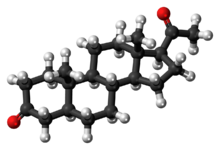Chemistry:5α-Dihydroprogesterone

| |

| |
| Names | |
|---|---|
| IUPAC name
5α-Pregnane-3,20-dione
| |
| Systematic IUPAC name
(1S,3aS,3bR,5aS,9aS,9bS,11aS)-1-Acetyl-9a,11a-dimethylhexadecahydro-7H-cyclopenta[a]phenanthren-7-one | |
| Other names
Allopregnanedione
| |
| Identifiers | |
3D model (JSmol)
|
|
| ChEBI | |
| ChemSpider | |
PubChem CID
|
|
| UNII | |
| |
| |
| Properties | |
| C21H32O2 | |
| Molar mass | 316.485 g·mol−1 |
Except where otherwise noted, data are given for materials in their standard state (at 25 °C [77 °F], 100 kPa). | |
| Infobox references | |
5α-Dihydroprogesterone (5α-DHP, allopregnanedione,[1] or 5α-pregnane-3,20-dione) is an endogenous progestogen and neurosteroid that is synthesized from progesterone.[2][3] It is also an intermediate in the synthesis of allopregnanolone and isopregnanolone from progesterone.
5α-DHP is metabolized by the aldo-keto reductases (AKRs) AKR1C1, AKR1C2, and AKR1C4 with high catalytic efficiency.[4] AKR1C1 preferentially forms 20α-hydroxy-5α-pregnane-3-one while AKR1C2 preferentially forms allopregnanolone.[4] Similarly AKR1C1 reduces and consequently inactivates allopregnanolone into 5α-pregnane-3α,20α-diol.[4] In contrast to the other AKRs, AKR1C3 has low catalytic efficiency for reduction of 5α-DHP.[4] These AKRs are highly expressed in the human liver and mammary gland but have relatively modest expression in the human brain and uterus.[5]
5α-DHP is an agonist of the progesterone receptor and a positive allosteric modulator of the GABAA receptor (albeit with an affinity for this receptor that is regarded as relatively low (in comparison to 3α-hydroxylated progesterone metabolites such as allopregnanolone and pregnanolone)).[2][3][6][7] It has also been found to act as a negative allosteric modulator of the GABAA-rho receptor.[8] The steroid has been found to possess 82% of the affinity of progesterone for the progesterone receptor in rhesus monkey uterus.[9] 5α-Dihydroprogesterone has been said to possess about 33% of the relative progestogenic potency of progesterone.[10] In addition, it is a weak agonist of the pregnane X receptor (PXR) (EC50 >10,000 μM), with approximately six-fold lower potency relative to its 5β-isomer, 5β-dihydroprogesterone.[11]
Allopregnanolone is transformed back into 5α-DHP by 3α-hydroxysteroid oxidoreductase, and conversion of allopregnanolone into 5α-DHP is responsible for the progestogenic activity of allopregnanolone.[6][12][13] 5α-DHP, via the progesterone receptor, and allopregnanolone, via the GABAA receptor, act together to induce lordosis in animals.[12][13] A study found that 41% of allopregnanolone that was administered via injection was transformed into 5α-DHP in the rat brain.[12]
Levels of 5α-DHP have been quantified.[14]
Chemistry
See also
References
- ↑ Finn, Deborah A.; Purdy, Robert H. (2007). "Neuroactive Steroids in Anxiety and Stress". Handbook of Contemporary Neuropharmacology. doi:10.1002/9780470101001.hcn026. ISBN 978-0470101001.
- ↑ 2.0 2.1 "Neurosteroid regulation of central nervous system development". Pharmacol. Ther. 116 (1): 107–24. October 2007. doi:10.1016/j.pharmthera.2007.04.011. PMID 17651807.
- ↑ 3.0 3.1 "The socially-isolated mouse: a model to study the putative role of allopregnanolone and 5alpha-dihydroprogesterone in psychiatric disorders". Brain Res. Brain Res. Rev. 37 (1–3): 110–5. November 2001. doi:10.1016/s0165-0173(01)00129-1. PMID 11744079.
- ↑ 4.0 4.1 4.2 4.3 "Role of aldo-keto reductase family 1 (AKR1) enzymes in human steroid metabolism". Steroids 79: 49–63. January 2014. doi:10.1016/j.steroids.2013.10.012. PMID 24189185.
- ↑ "Human 3alpha-hydroxysteroid dehydrogenase isoforms (AKR1C1-AKR1C4) of the aldo-keto reductase superfamily: functional plasticity and tissue distribution reveals roles in the inactivation and formation of male and female sex hormones". Biochem. J. 351 (Pt 1): 67–77. October 2000. doi:10.1042/bj3510067. PMID 10998348.
- ↑ 6.0 6.1 "Progesterone receptor-mediated effects of neuroactive steroids". Neuron 11 (3): 523–30. September 1993. doi:10.1016/0896-6273(93)90156-l. PMID 8398145.
- ↑ Ocvirk, Rok; Pearson Murphy, Beverley E.; Franklin, Keith B.J.; Abbott, Frances V. (2008). "Antinociceptive profile of ring A-reduced progesterone metabolites in the formalin test". Pain 138 (2): 402–409. doi:10.1016/j.pain.2008.01.019. ISSN 0304-3959. PMID 18343034.
- ↑ "Medicinal chemistry and molecular pharmacology of GABA(C) receptors". Curr Top Med Chem 2 (8): 903–13. 2002. doi:10.2174/1568026023393453. PMID 12171579. http://sydney.edu.au/medicine/pharmacology/adrien-albert/images/pdfs/RefsPDFs/350.pdf.
- ↑ "A specific progesterone receptor of myometrial cytosol from the rhesus monkey". J. Steroid Biochem. 8 (2): 157–60. February 1977. doi:10.1016/0022-4731(77)90040-1. PMID 405534.
- ↑ Rogerio A. Lobo; Jennifer Kelsey; Robert Marcus (22 May 2000). Menopause: Biology and Pathobiology. Academic Press. pp. 433–. ISBN 978-0-08-053620-0. https://books.google.com/books?id=i9HXKhjvNVAC&pg=PA433.
- ↑ "The human orphan nuclear receptor PXR is activated by compounds that regulate CYP3A4 gene expression and cause drug interactions". J. Clin. Invest. 102 (5): 1016–23. 1998. doi:10.1172/JCI3703. PMID 9727070.
- ↑ 12.0 12.1 12.2 "Indomethacin inhibits lordosis induced by ring A-reduced progestins: possible role of 3alpha-oxoreduction in progestin-facilitated lordosis". Horm Behav 35 (1): 1–8. February 1999. doi:10.1006/hbeh.1998.1457. PMID 10049597.
- ↑ 13.0 13.1 "Ring A reduced progestins potently stimulate estrous behavior in rats: paradoxical effect through the progesterone receptor". Physiol. Behav. 58 (5): 985–93. November 1995. doi:10.1016/0031-9384(95)00141-5. PMID 8577898.
- ↑ "Reproducibility of an assay to measure serum progesterone metabolites that may be related to breast cancer risk using liquid chromatography-tandem mass spectrometry". Horm Mol Biol Clin Investig 23 (3): 79–84. September 2015. doi:10.1515/hmbci-2015-0026. PMID 26353176.
 |

